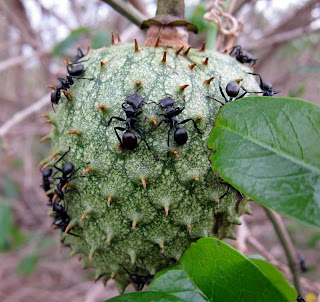
The latter half of the Peak of Diversity Bolivia tour took in the Villa Tunari area, the Chapare Road, and the area around Cochabamba. The lower elevations were surprisingly devoid of mixed flocks, but we still managed to see some good birds. Oilbird, Amazonian Umbrellabird, White-shouldered Antshrike, and Short-tailed Pygmy-Tyrant were some of the highlights. The forest here was gorgeous.

On one afternoon we went a little higher up the highway (to 2700 feet) where we found Upland Antshrike and White-bellied Pygmy-Tyrant, but not much else. We made a quick stop to look at some parrots that landed in trees and took the opportunity to ask the locals what in the world they were drying on the roadside. Turned out to be turmeric. It's a root from a plant in the ginger family, and it's used here in making mustard (presumably only as a colorant).

Not far from here was this gorgeous orchid Bletia catenulata growing on the shoulders of the highway. Thanks to Roberto Vásquez for the ID.

This easily recognized bess beetle, family Passalidae, was crawling across the road the next day at our birding stop at 5600 feet. Bugguide says there are about 500 species worldwide, but I don't know if anyone has looked at the Bolivia species.

I've always been fascinated by milkweed vines, and the twisted petals of this one were particularly attractive. Genus Matalea?

My friend Michael Harvey was able to identify quickly my photos of this Opipeuter xestus, which appeared to be common around 6500 meters elevation, such as where we had lunch at a trout farm. It's the only species in the genus, family Gymnophthalmidae.

On our last morning on the humid slope of the Andes we had a picnic breakfast under beautiful skies at 10,000 feet at the upper end of the Chapare cloudforest. Birds were really good here, and at this spot we watched two dueling Black-hooded Sunbeams, an endemic hummingbird.
This large Senecio sp. bush had a foul smell. In the close-up you can see the single series of even-length, dark-tipped phyllaries (the bracts under the flower head) that are characteristic of this huge genus.

This looks like a giant, lustrous ladybug and is probably in the same family, Chrysomelidae.

We made a short stop on the way back to Cochabamba to look for an Andean Swallow near Colomi.

Our last days were spent up the Cerro Tunari road, where we made it as high as 14,860 feet.

There is one village up here, apparently called Mis Llamas. And there are indeed many llamas here.
Some of us took a hike to look for Short-tailed Finch, which has an easily identified habitat, even if the birds aren't so easy to find.

And here's another shot of the Diademed Sandpiper-Plover (left of center) in the rocky, wet outwash I found it in.

The lower parts of the road have some nice brushy areas where we saw some great birds, such as Wedge-tailed Hillstar, Bolivian Warbling-Finch, and this endemic Cochabamba Mountain-Finch.

The botanizing here is also fun. This is Alonsoa acutfolia, Scrophulariaceae.

We spent our last morning at Laguna Alalay right in the city, where a vagrant Sick's Swift (perhaps a first record for the department of Cochabamba), and my lifer Puna Snipe were the best finds. But the excellent views of a Many-colored Rush-Tyrant and the good diversity of water birds made it a great stop.

After flying back to Santa Cruz (perhaps the quickest, most hassle-free flight any of us have ever had), we had time to drive north of our hotel and bird some open country. This Campo Flicker was right next to a busy road.

A Red-crested Cardinal on a Jacaranda tree.

This one last photo wasn't on our drive, but it was in the same region, on our first day of the tour. The fruit itself is interesting enough, a wild relative of the chirimoya and guanabana, family Annonaceae. But fascinating was that about half of the fruits on the tree were being guarded by these broad-headed ants that didn't seem to be doing anything on them. I think of my friend Lloyd Davis every time I see an interesting ant. These moved about aggressively when I touched the fruit, but they otherwise were sitting motionless and weren't anywhere else on the tree. Feel free to post a comment if you know what these are.

























